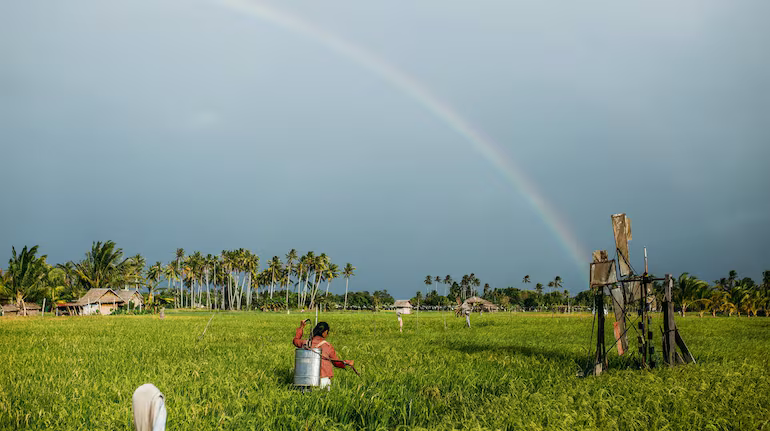Tags
Golden era of rice irrigation has arrived
Many irrigation options await growers who produce rice.

Growers have seven, eight or possibly even nine systems, depending on how you count them, for keeping their crops watered during the long Mid-South growing season, according to Joe Massy, with the USDA-ARS Delta Water Management Research Unit in Jonesboro, Ark. BRENT MURPHREE
It hasn’t been that long ago that the only way to irrigate rice was to build a system of levees strong enough to keep water at a prescribed depth on a field until it was ready to be drained and harvested.
Fast forward to 2024 and rice farmers now have seven, eight or possibly even nine systems, depending on how you count them, for keeping their crops watered during the long Midsouth growing season.
“I feel like we’ve entered a golden era for rice irrigation,” said Joe Massey, a research agronomist with the USDA-ARS Delta Water Management Research Unit in Jonesboro, Ark. “I’ve counted seven or eight different ways that we can now irrigate rice – nine if you include sprinkler irrigation – and I know one grower who is using a combination of furrow and cascade.”
Massey spoke on “A Golden Era for Rice Irrigation: Advancements and Opportunities” at the Master Irrigator Program Conference organized by Drew Gholson, Extension irrigation specialist at Mississippi State University’s Delta Research and Extension Center earlier this year.
Improving efficiency
In his 20 years of working on rice irrigation, first at Mississippi State and then with USDA’s Agricultural Research Service, Massey has never seen so much activity aimed at improving irrigation efficiency and water conservation until recently.
Starting with cascade, the term used for the system of levees or gates or spills that growers have relied on for decades, Massey next lists Early Cascade Irrigation Shutoff or ECIS, a modification of the cascade system he has been working on to help reduce water use in levee rice.
“Then there’s multiple inlet rice irrigation or MIRI, MIRI plus alternate wetting and drying (or AWD), zero grade rice irrigation, zero grade plus AWD and furrow-irrigated or row rice,” he said. “The pit-less furrow-irrigated rice system developed by Dr. Chris Henry with the University of Arkansas would be eight, and sprinkler irrigation could be the ninth.”
The use of poly-tubing in the early 1990s was a major breakthrough for rice irrigation in the Delta region. “The Pipe Planner software by Delta Plastics came out in about 2014, and that was another key step in making MIRI, and now row rice irrigation more effective and efficient,” he said, noting that growers use the program to determine the best tubing and hole sizes.
“If you don’t like poly-tubing, we’ve come up with a way that, according to our modeling, can be as efficient as MIRI just by triggering earlier shutoff of the cascade system,” he said. “We have two years of validation of ECIS, and it’s higher than projected. I’m not sure that (26) percent will hold, but the field results are mirroring the modeling.” (ECIS uses a flood-depth monitor to notify the grower or send a signal to automatically shut off the irrigation pump when the water level reaches optimum in the next to last rice paddy.)
Furrow irrigated
For growers who don’t like working with levees, there’s furrow-irrigated rice, which now accounts for about 20% of the rice acres in Arkansas, according to the University of Arkansas Extension Service. While studies show yields can be lower for row rice, farmers say the savings on equipment wear-and-tear, fuel and labor and quality of life improvements more than offset the yield loss as compared to conventionally flooded rice.
“Chris Henry’s goal of achieving yields of 300 bushels of rice with 12 inches of water is a sign of more innovation with the Recirculating Furrow-Irrigated, Fertigated Rice Irrigation System he developed,” Massey said. “Much of this has occurred in the last six years.”
He also talked about efforts to automate systems so that growers don’t have to do things like shut off irrigation wells at night in the rain, a topic he covered in a recent article in Delta Farm Press.
“I also asked the growers attending the Master Irrigator Program if they like to compete” he said. “Although I was speaking in Mississippi, I was referring to the Most Crop Per Drop Contest, which is in its sixth year in Arkansas.
“If you’re a numbers or information-type person, the contest lets you compare your results with some of the best producers in our area,” he noted. “I gave an example of 196 bushels of rice grown with 19 inches of water, which is good by most standards. But how does that 10 bushels of rice per inch of applied irrigation compare to some of the best producers in the Midsouth?”
That’s where the University of Arkansas’ Most Crop Per Drop Contest, also developed by Henry, comes in. “We did not have these numbers six years ago.”
Conservation funding
Massey also talked about the increasing amount of dollars available for conservation programs. He quoted Jim Whitaker, a rice farmer and chair of the Arkansas Rice Promotion Board, as saying: “Rice is seen as ‘low-hanging fruit’ for companies seeking to reduce water use and methane emissions.”
“That’s true for both ag companies and non-ag companies,” Massey said. “Twenty years ago, I was telling our farmers that one day they could possibly get carbon credits for methane reductions. Now that’s becoming a reality.”
In summary, he said, “There has never been a time when producers have had more:
- Ways to irrigate rice.
- Details on how to do this.
- Funds available to participate in a wide variety of programs.
- The potential to improve the quality of life of producers, families and employees.”
Published Date: May 2, 2024






